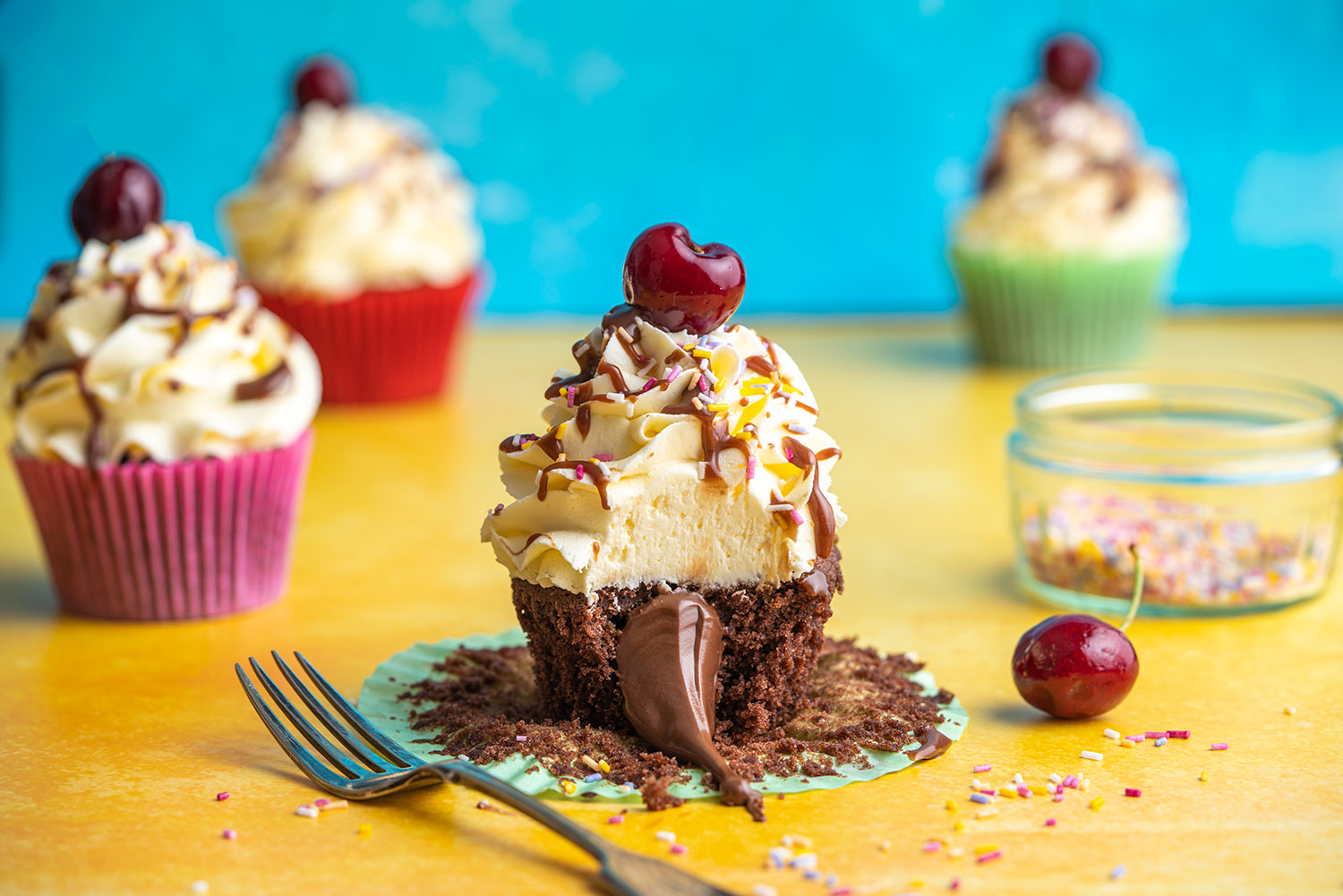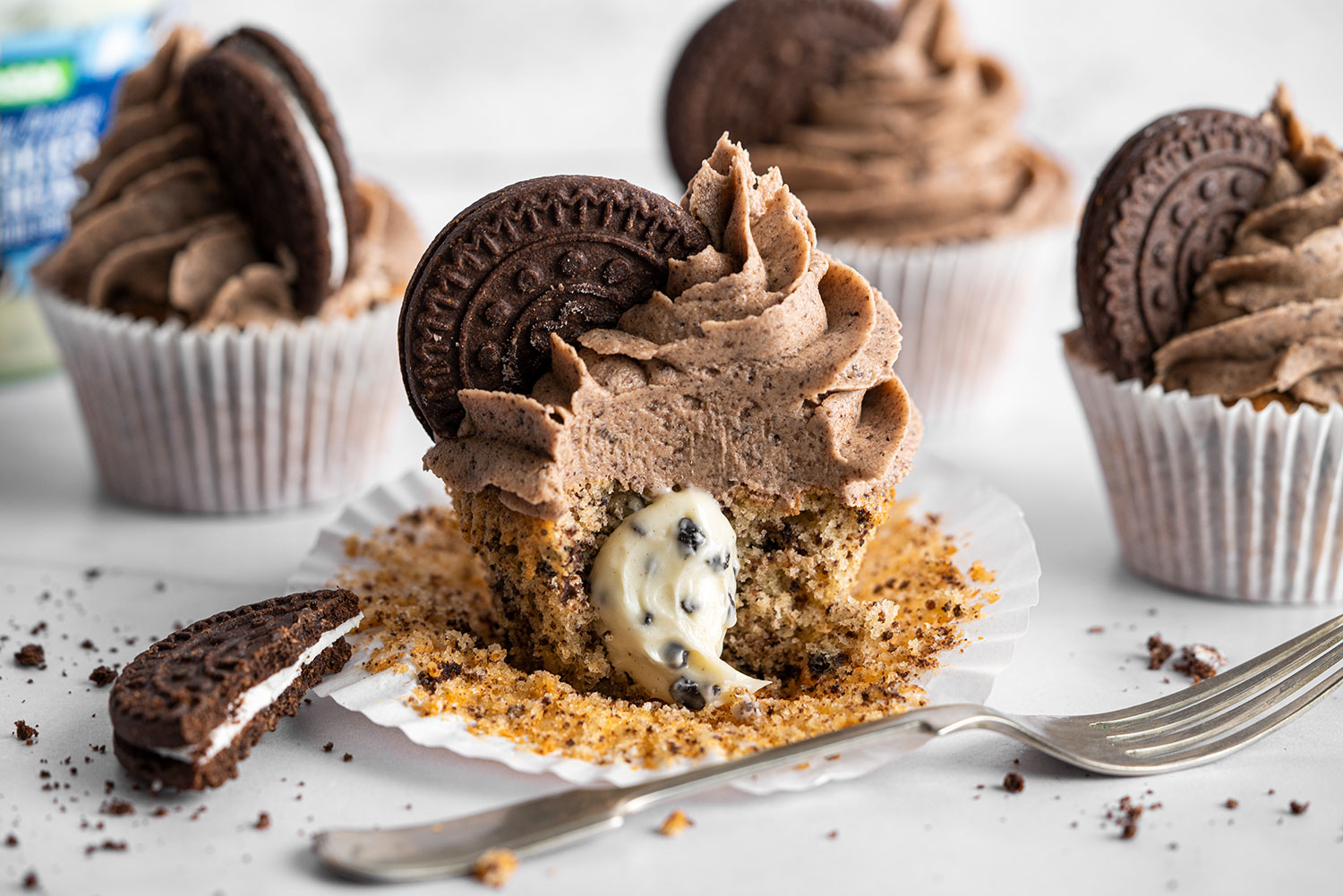Gluten-free shortcrust pastry recipe – using just 5-ingredients! This is the ULTIMATE pastry, simply because nobody would ever know it’s Coeliac-friendly and wheat-free.
Gluten-free shortcrust pastry recipe – delightful, golden, flaky pastry that’s perfect for sweet and savoury tarts, pies and pasties. And no, it doesn’t taste ‘gluten-free’ whatsoever!
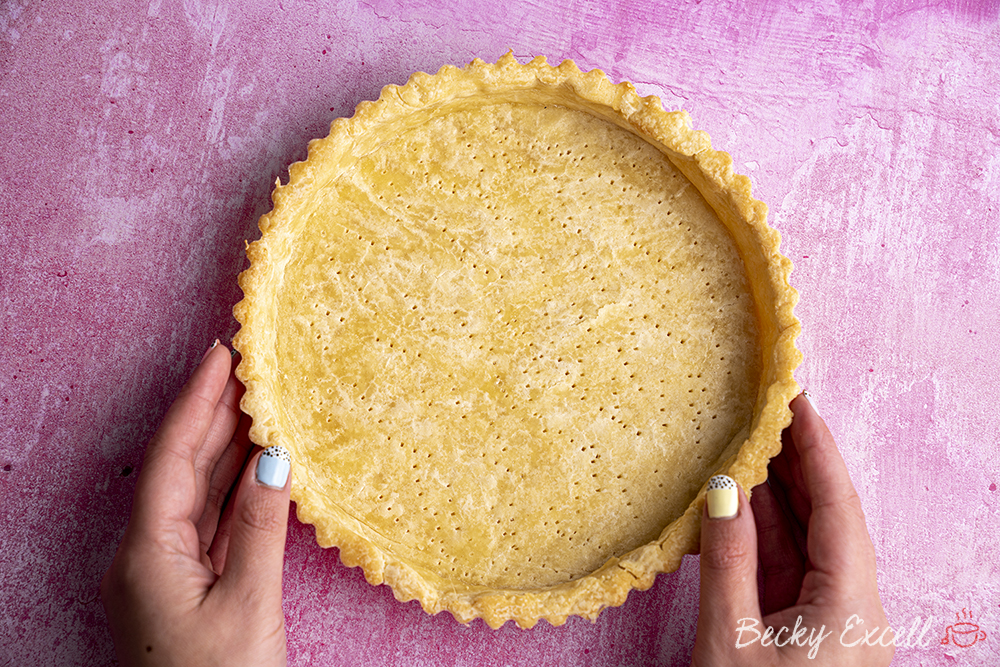
If you’ve got my first book ‘How To Make Anything Gluten-free‘, you might notice that this differs to the one in that book. So what’s the difference?
The shortcrust pastry recipe in my first book is literally identical to ‘muggle’ (people who can eat gluten) shortcrust pastry in terms of taste, texture and appearance. And it’s awesome, if I do say so myself!
However, this gluten-free shortcrust pastry recipe is slightly richer in taste AND it has a lovely flaky quality that puts it somewhere between shortcrust and rough puff pastry.
So which one should you use? The choice is yours! I find that this recipe is a little more versatile when it comes to using it for things like gluten-free Cornish pasties as well as for savoury or sweet pies. But in reality, both work just as well!
Gluten-free shortcrust pastry recipe: What you’ll need…
- Gluten-free plain flour: I use Doves Farm’s FREEE gluten-free plain flour blend that you can find in the supermarket. Can’t find it in your part of the world? You can always use my homemade gluten-free plain flour blend.
- Xanthan gum: This is used as a binding agent in the absence of gluten and integral in gluten-free baking. You can find it in your supermarket’s free from aisle or online.
- Caster sugar (optional): This is optional as you’ll only need to add this if you’re making a sweet tart or pie.
- Salt (optional): And if you’re making a savoury tart or pie, add a little salt instead of sugar instead.
- Butter: This is a super-important ingredient in gluten-free shortcrust pastry as, when cold, butter has brilliant strength and malleability. Bear in mind that once warm, it gets very sticky, so we’ll always be trying to keep our dough as cold as possible.
- Large eggs: As eggs are our only liquid in this recipe, I’d advise using large as that’s what I used to create this recipe – medium eggs may result in the dough being a little dry and crumbly when working with it.
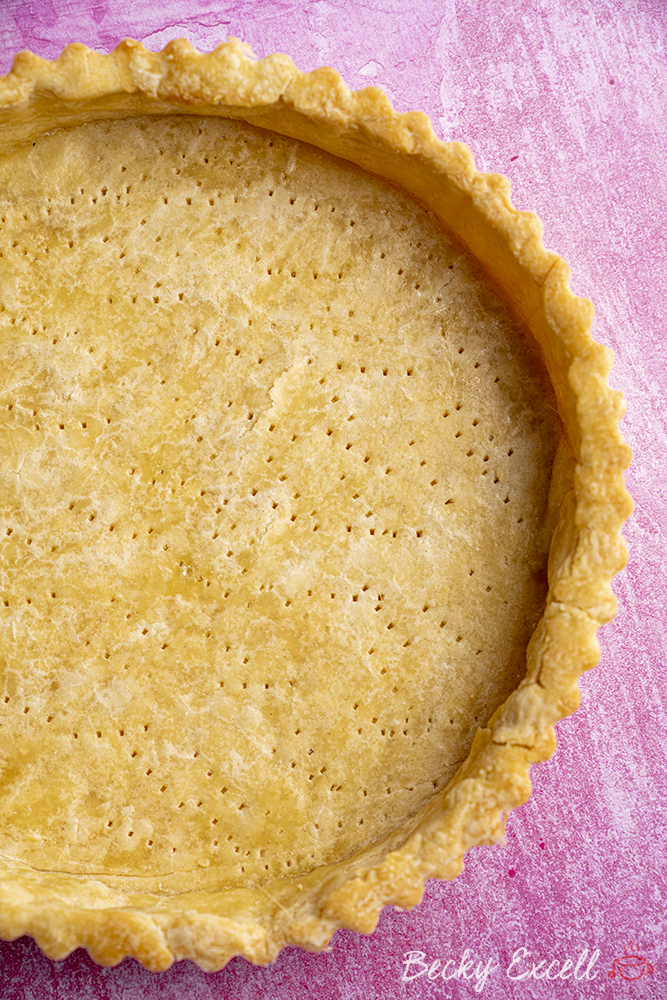
And guess what? I was so pleased with this recipe that I put it in my second book ‘How To BAKE Anything Gluten-free’. which is released at the end of September 2021. So if you get practising with this recipe now, you’ll be able to use it throughout that book!
So how does my gluten-free shortcrust pastry taste? Firstly, it has a beautiful buttery taste with a flaky, slightly crumbly texture that doesn’t disintegrate into dust when you bite into it.
It adds a more luxurious taste no matter what filling you opt for and to be honest, you just can’t go wrong with it. Here’s a few ideas you can use it for:
What can I make with gluten-free shortcrust pastry?
- Pumpkin Pie
- Coronation Quiche
- Quiche Lorraine (recipe in my first book)
- Cornish Pasties (recipe in my second book)
- Apple Pie (recipe in my second book)
- Lemon Tart
- Mince Pies
- Festive pigs in blanket sausage rolls (recipe in my second book)
- Jam Tarts
- Pop Tarts (recipe in my first book)
- Chicken and Leek Pie (recipe in my first book)
Gluten-free shortcrust pastry recipe: Frequently Asked Questions
Can I make this recipe gluten-free? Is it suitable for Coeliacs?
It is gluten-free, though nobody would know just by tasting it – trust me!
Bear in mind that minimising cross-contamination is hugely important if you’re Coeliac or making this for someone who is. Here’s some tips from Coeliac UK on minimising the risk of cross contamination.
Also, make sure that all ingredients used don’t have any gluten-containing ingredients. Then make sure that they also don’t have a ‘may contain’ warning for gluten, wheat, rye, barley, oats (which aren’t gf), spelt and khorasan wheat (aka Kamut).
Here’s some more info from Coeliac UK on identifying safe gluten-free products.
Can I make your gluten-free shortcrust pastry recipe dairy-free?
Yes! All you need to do is use a block of Stork hard margarine instead of butter. As it isn’t as firm as butter, you’ll likely need to chill the dough for a little longer, so do bear that in mind.
Can I make your gluten-free shortcrust pastry recipe vegan?
I personally haven’t tested this recipe using egg replacers and as eggs are so vital when creating pastry without gluten, I’m hesitant to say it can be done.
That is, of course, until I try it for myself! So watch this space and I’ll let you know how it goes.
Is this recipe low FODMAP?
Yes! It’s low FODMAP and as long as your fillings are too, then your finished product will be suitable for the elimination phase of the diet.
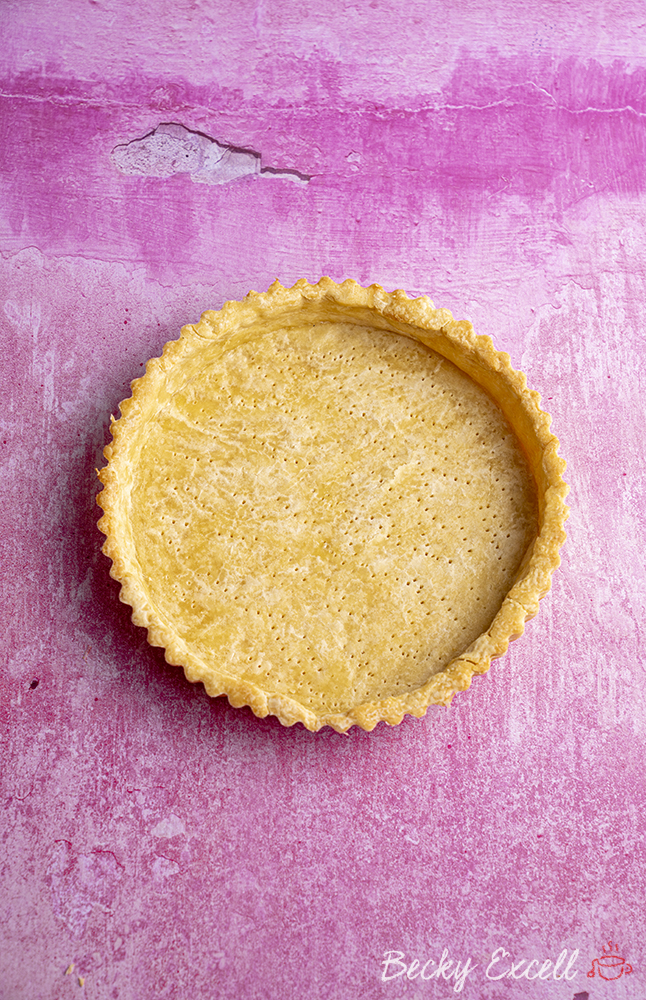
How much pastry does this recipe create? How many tarts, pies and pasties can I make with it?
Officially, this recipe creates enough pastry to line a 23cm loose-bottom, fluted tart tin. So that’s one pastry case you can use for a quiche, lemon tart or one big custard tart etc.
It’s also enough to make 12 mince pies (with lids) or two large gluten-free Cornish pasties.
However, when it comes to making a large lidded pie (23cm or slightly larger), you won’t have enough pastry to make a lid! So, if making a lidded pie, you’ll need to make one and a half quantities of pastry dough.
Fortunately, you can easily do this by multiplying all of the measurements of the ingredients in the recipe below by 1.5.
Can I make this gluten-free shortcrust pastry recipe using a food processor or a stand mixer?
Yes to a food processor, but no to a stand mixer. That’s simply because a stand mixer cannot achieve the lovely breadcrumb-like consistency that you end up with when you rub butter and flour together using your fingers.
However, a food processor can! Just please don’t over mix your flour/xanthan gum and butter mixture into a strange, buttery flour paste – your pastry won’t work. Once you achieve a breadcrumb-like consistency… stop!
How’s best to get the rolled out pastry into the tart tin or pie dish?
First of all, rolling your dough out on non-stick baking paper is a great idea. Then, all you have to do is simply lift the rolled out dough (on the paper) and quickly (but gently!) invert it on top of your tart tin or pie dish. Job done.
If you’re having a nightmare where it keeps breaking or falling apart as you do this, you’ve probably gone wrong somewhere along the line. Either your butter combined too much with the flour (over mixing) or your dough wasn’t chilled for long enough – this dough has surprising strength when chilled!
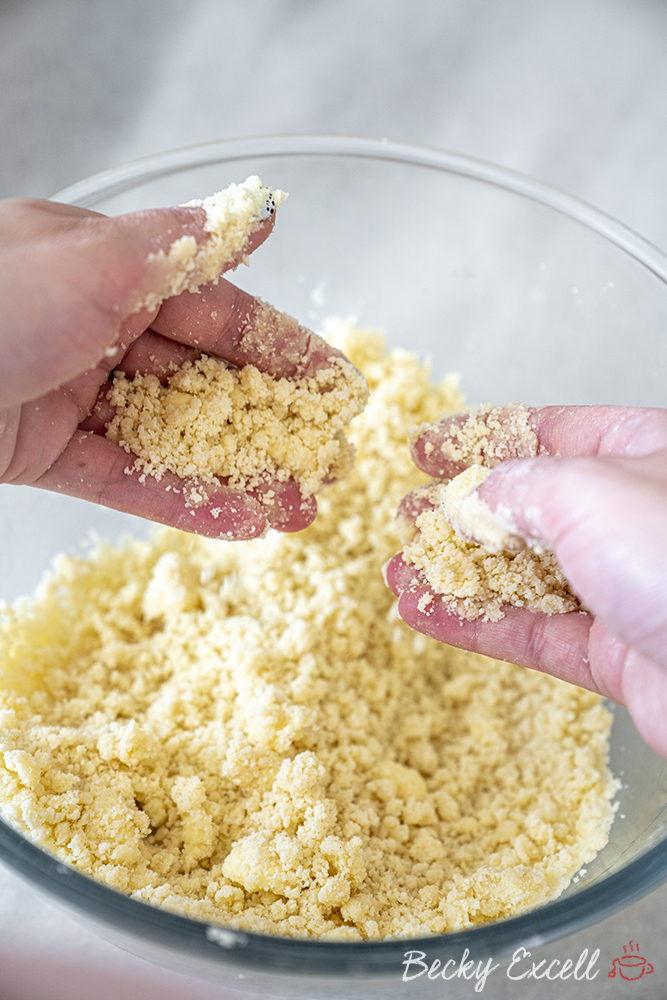
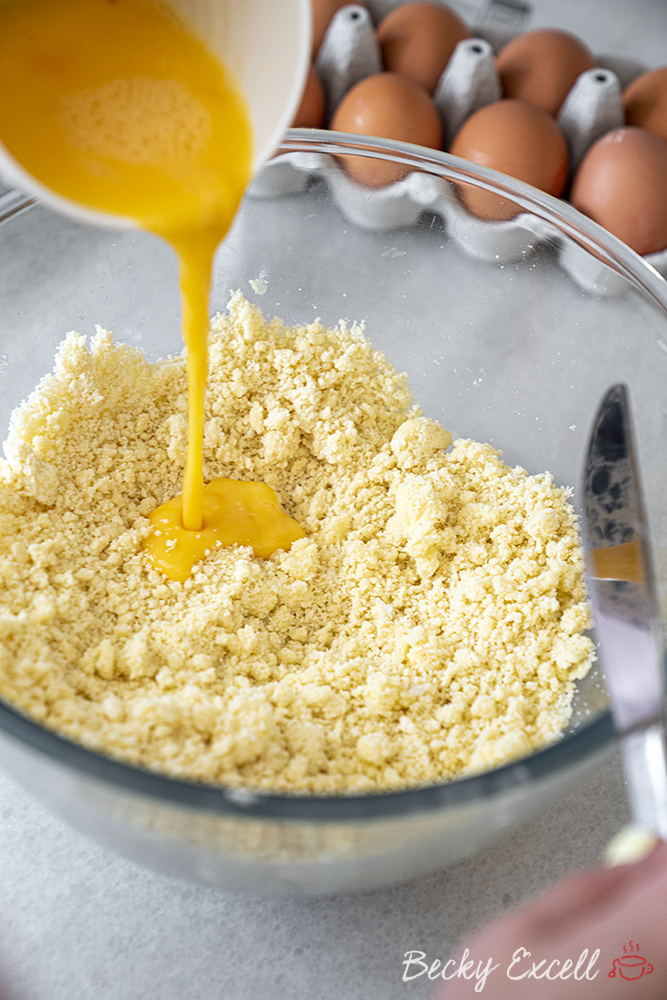
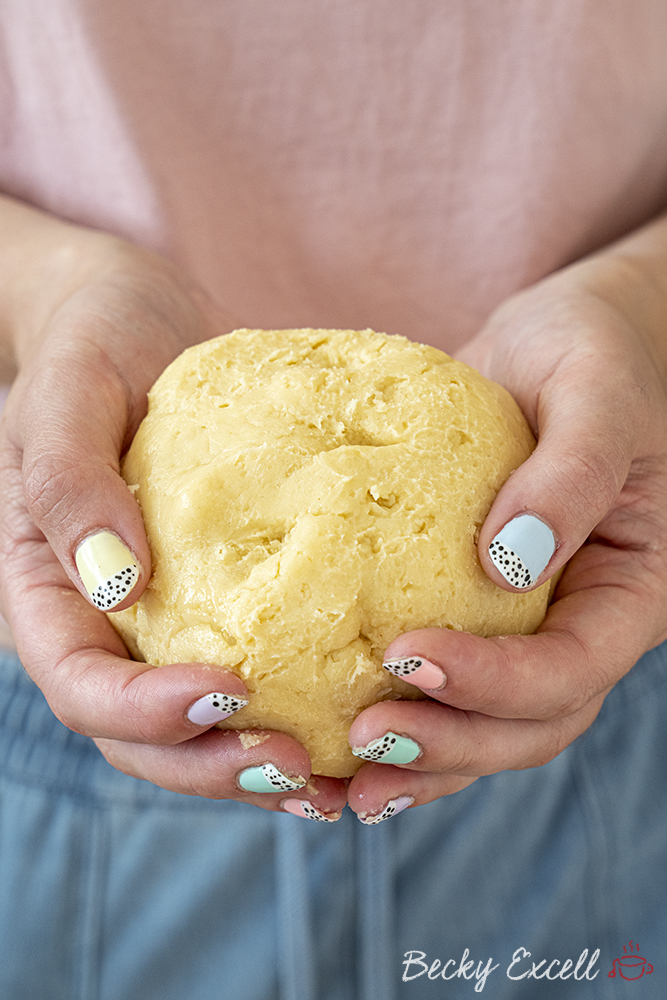
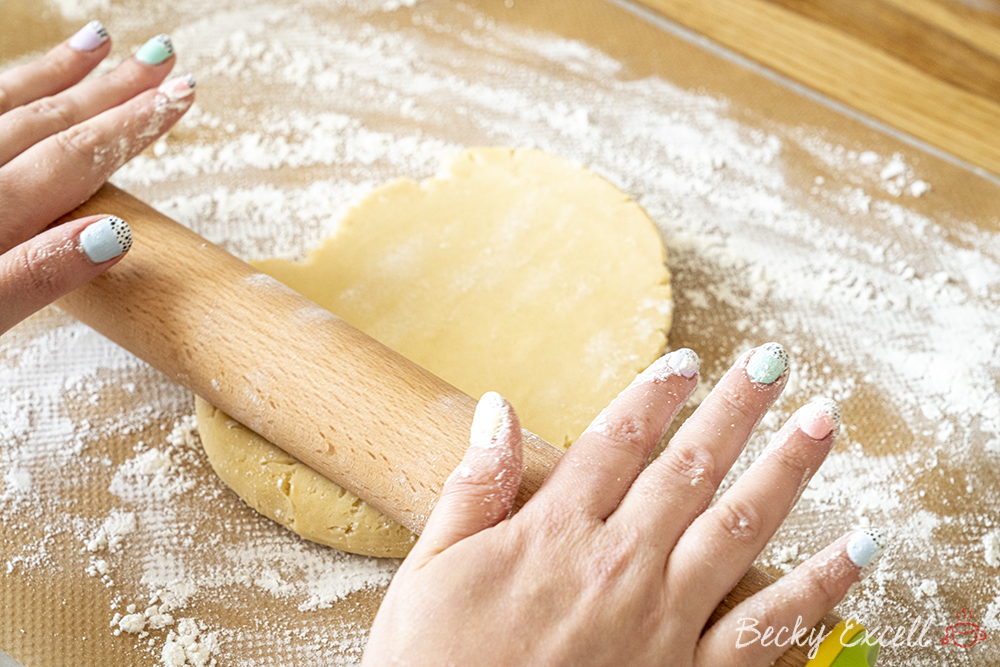
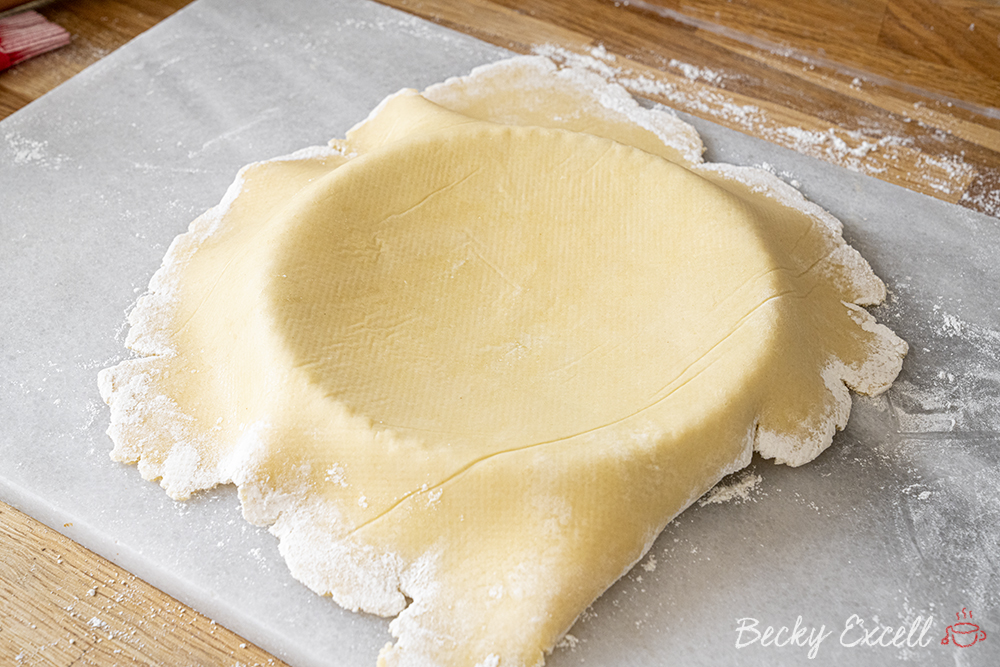
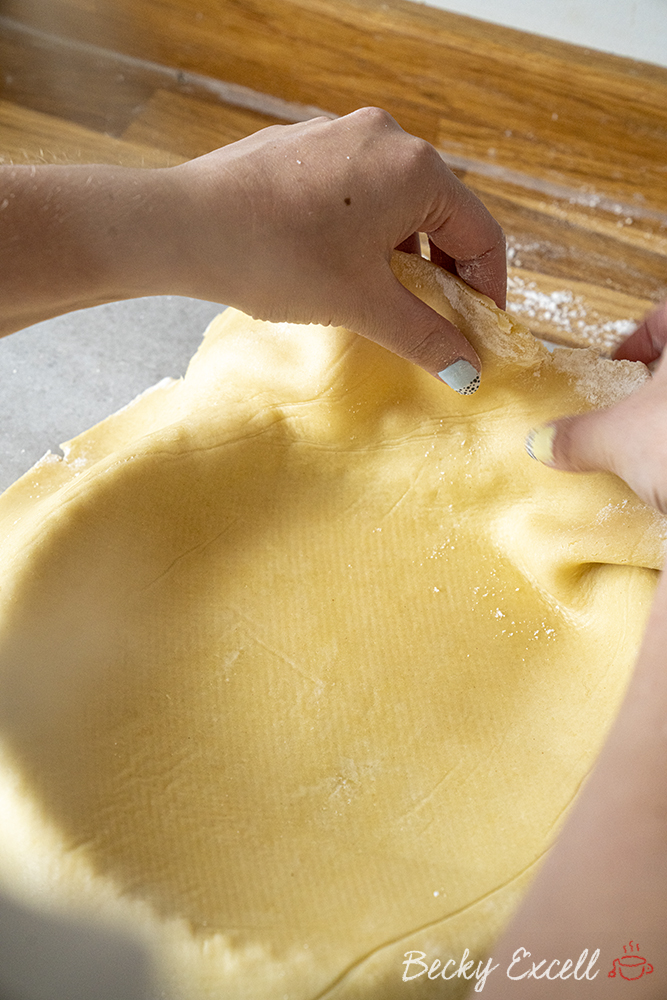
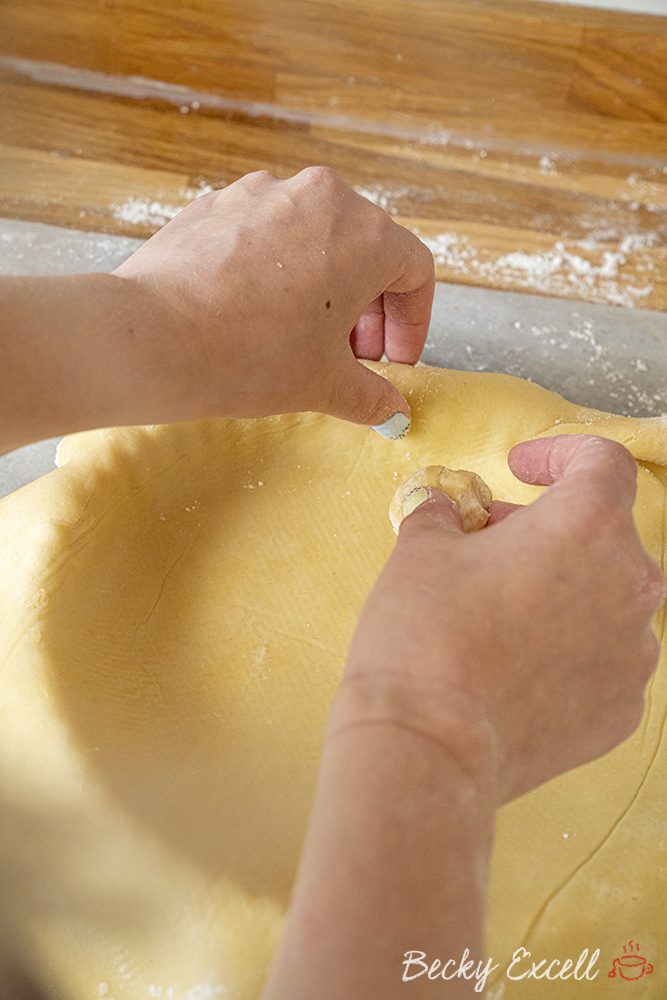
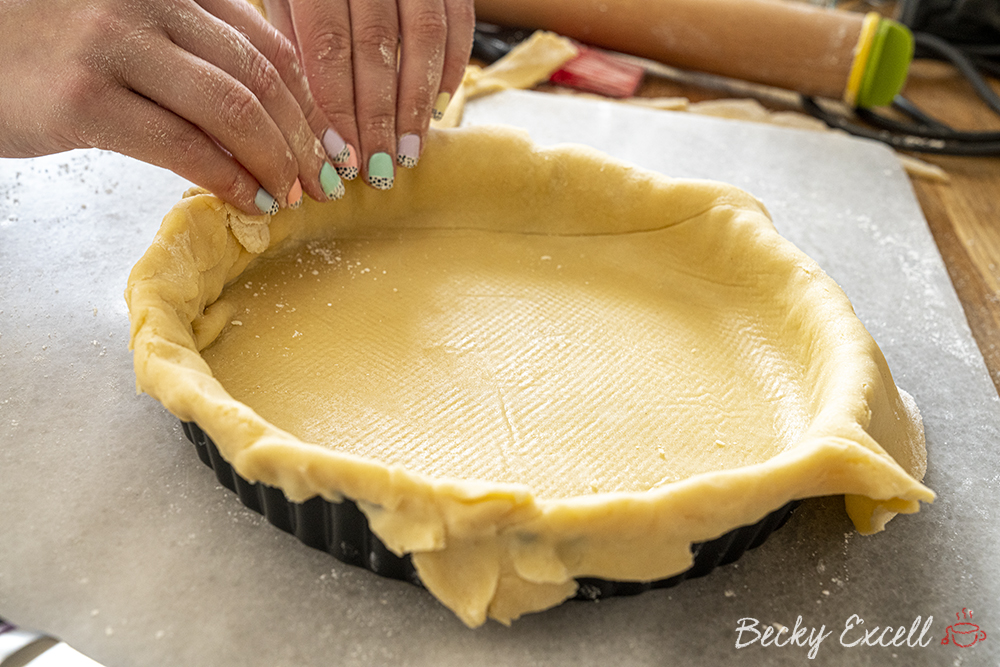
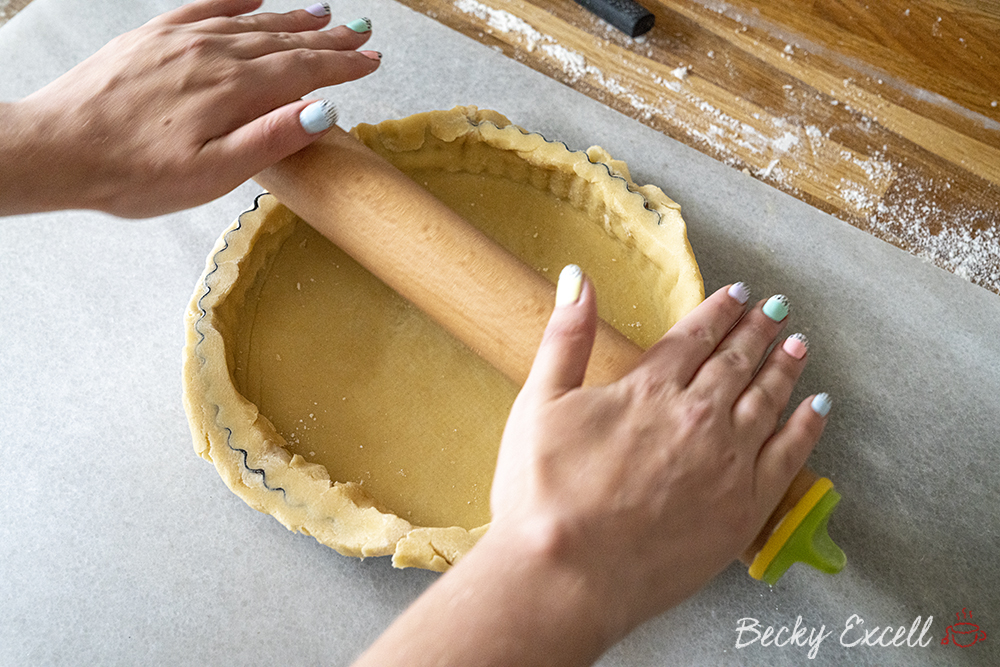

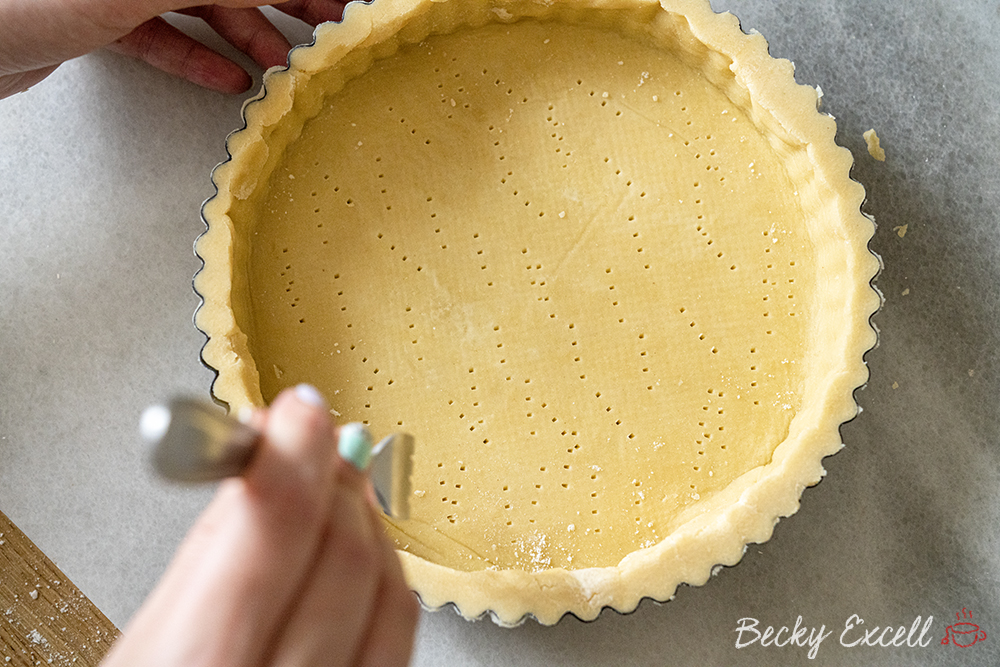
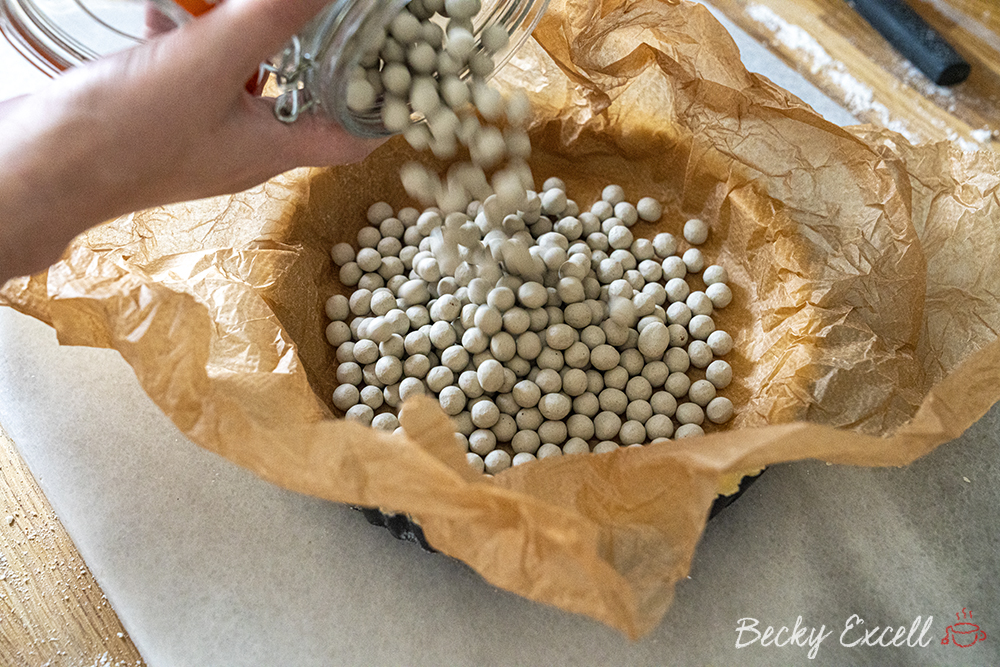
Gluten-free shortcrust pastry recipe: Tips for pastry perfection
- Keep it cold! Ensure your butter is nice and cold before starting and that your pastry is chilled until firm, yet malleable. The cold temperature of the dough ensures you can roll out your pastry without it breaking, so handle it as little as possible – your hands are warm after all!
- Don’t bring the mixture together into a ball too quickly. It might feel like you can very shortly after the egg is cut in, but please resist and continue cutting in for a minute or two! If the egg isn’t adequately cut in, your pastry will be dry and brittle to work with.
- If blind baking, use baking beans (or rice) for the first 15 minutes of baking. A perfect pastry case is lovely and flat – agreed? Without a little weight inside the case when baking, it can rise up in the middle which will cause it to crack. So please use baking beans or rice to prevent this!
- Once chilled, ensure your pastry dough ball isn’t rock solid. Of course, this is because it’ll be near impossible to roll out! It should be firm, yet workable. If it is solid, simply leave out at room temperature until workable enough to roll out.
- If blind baking, brush the base with egg-white when you’re finished and return to the oven for 1 minute. This helps to seal the base of the pastry case, ensuring your filling doesn’t leak through to create a soggy bottom.
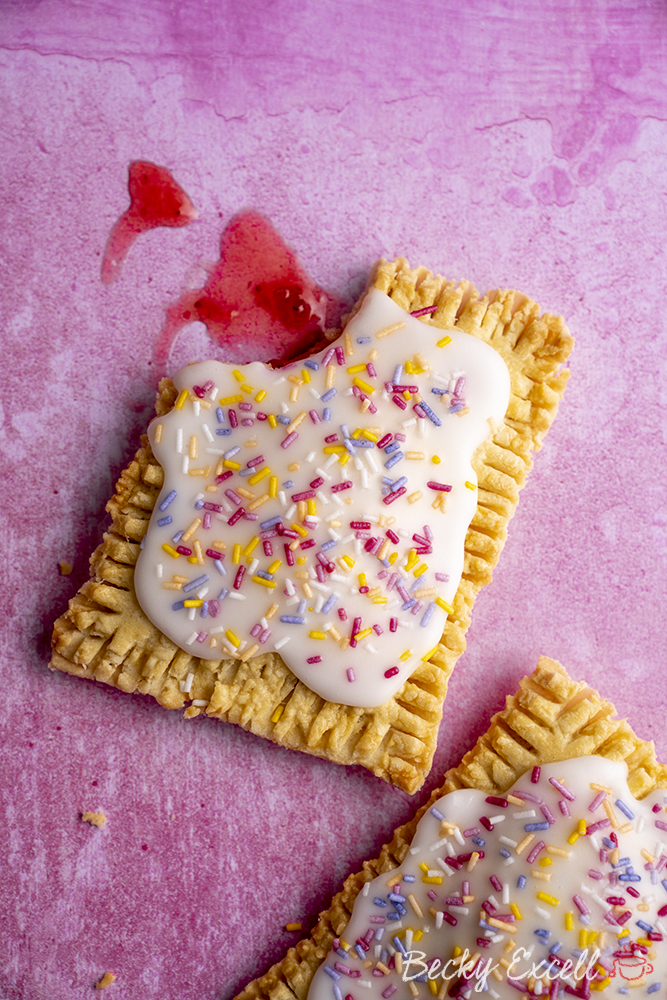

Gluten-free Shortcrust Pastry Recipe (low FODMAP + dairy-free option)
Equipment
Ingredients
- 300 g gluten-free plain flour plus extra for dusting
- 1½ tsp xanthan gum
- 145 g butter very cold and cubed (use Stork hard margarine if dairy-free)
- 3 tbsp caster sugar add only if making sweet pastry
- 1 tsp salt add only if making savoury pastry
- 2 large eggs beaten
Instructions
To create the dough:
- Place your flour, xanthan gum, into a large mixing bowl and mix. Make sure your butter is cold and straight from the fridge before using! Cut the butter into small cubes and rub it in using your fingers until the mixture resembles breadcrumbs.
- If making sweet pastry, stir in the caster sugar, or salt, if making savoury pastry.
- Beat your 2 eggs together and gradually add them, cutting it into the mixture using a knife until it comes together. It should form a ball and not be very crumbly – it might be a tiny bit sticky but very minimally.
- Wrap your pastry in cling film or place into a sandwich bag. Place in the fridge for 30 minutes until firm yet workable – it shouldn’t be rock solid!
To create a 23cm tart case:
- Preheat your oven to 200C/180C fan.
- Once your pastry dough is chilled, place it onto a lightly floured sheet of non-stick baking paper. Using a lightly floured rolling pin, roll it out into a large circle, around 2mm thick.
- Transfer the pastry sheet into a 23cm fluted, loose-bottom tin. I do this by supporting the pastry as I gently invert it into the tin, with equal overhang on all sides. Peel off the baking paper.
- Next, use your fingers to carefully ease the pastry into place, so that it neatly lines the tin. Lift the overhanging pastry and, using your thumb, squash 2mm of pastry back into the tin. This will result in slightly thicker sides which will prevent your pastry case from shrinking when baked.
- Allow the overhang to do it’s thing – we’ll trim the overhang after chilling it. Lightly prick the base of the pastry case several times with a fork and then place into the fridge for 15 minutes.
- After chilling, use a rolling pin to roll over the top of the tin, instantly removing the overhang and flattening down the pastry.
- Next, loosely line the base of the pastry case with a piece of scrunched up baking paper and fill with baking beans (or rice if you don’t have any). Place onto the hot baking tray in the preheated oven for 15 minutes.
- After 15 minutes, remove the baking paper and baking beans, then bake for a further 5 minutes. Optionally, brush the inside of the case with egg-white then return to the oven for an extra minute – this helps to prevent soggy bottoms for wet fillings!
- You’re done! At this point, you can use the pastry case to make a quiche, lemon tart or Bakewell tart etc.
To create jam tarts:
- Once your pastry dough is chilled, place it onto a lightly floured sheet of non-stick baking paper. Using a lightly floured rolling pin, roll it out into a large circle, around 2mm thick.
- Use fluted or circular biscuit cutters (that are slightly bigger than the holes in a cupcake/muffin tray) to create as many circles as you can – feel free to reroll any offcuts to get as many circles as possible.
- Place the circles into a lightly greased cupcake tray. Fill with the jam of your choice and bake for 12-18 minutes. Transfer to a cooling rack to cool.
For everything else:
- Once your pastry dough is chilled, place it onto a lightly floured sheet of non-stick baking paper. Using a lightly floured rolling pin, roll it out into a large circle, around 2mm thick.
- Now use it for whatever you like! In addition to everything mentioned above, at this point, I use it to create pop tarts (recipe is in my first book), festive sausage rolls (recipe is in my second book) and savoury pies (recipes in my first and second book).
Nutrition
Thanks for reading all about my gluten-free shortcrust pastry recipe! If you make it, I’d love to see how it turned out so don’t forget to take a snap of your creations and tag me on Instagram!
Any questions about the recipe? Please do let me know by following me on Instagram and leaving me a comment on a recent photo!
Thanks for reading,
Becky xxx
Don’t forget to pin this for later!



